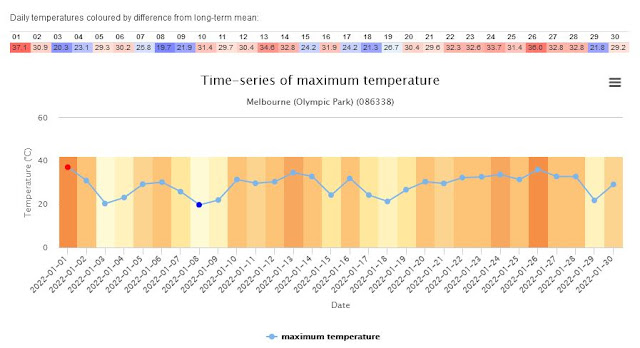 |
| BOM: Average Tmin deciles for January |
Sleepless in Melbourne? January was a warm one for Melbourne despite presence of La Nina (ENSO) which usually cools global temperatures marginally.
The trend was particularly noteable with record mean minimum temperatures for Melbourne and most of Victoria this year. Victoria's January mean minimum temperatures are rising faster than mean maximum temperatures.
There was also record humidity for January for most of Victoria. Record rainfall was also recorded in north east Victoria.
It seems there will be lots more sleepless January nights in store for us all in Melbourne in future years.
Temperature records
🌡️Melbourne mean minimum temperature for January 2022 (18.3 degrees) highest on record, about 4 degrees above the long-term average.
🌡️Melbourne had most 30C plus days in a month = 17, equalling January 1974 record. (Source: @BOM_vic on twitter)
While Melbourne's hottest day was 37.1C, there were no days over 40C, and only 2 exceeding 35C in January. A low intensity heatwave produced a series of days over 30C (17 in total) and warm nights often hovering around or over 20C for much of the night.
Melbourne's mean average number of days ≥ 30C is 8.6, and 3.8 days ≥ 35C for January.
 |
| Source: The Age |
 |
| BOM: timeseries for Tmax for January 2022 (Olympic Park) via twitter |
 |
| BOM: Timseries for January Victoria Minimum temperatures 1910-2022 |
 |
| BOM: Minimum temperature deciles for Victoria for January 2022 |
Humidity (Vapour Pressure)
Humidity was also high setting new January records for 9am and 3pm average Vapour Pressure for Melbourne and Victoria.
Melbourne set records for humidity during January 2022. High temperatures (17 days >30C) plus High humidity poses high serious heathealth risks for many people.
 |
| BOM Vapour Pressure Anomaly (Humidity) for Victoria January 2022 |
Rainfall
More rain to be expected in a La Nina year, but climate change also supercharges the hydrological cycle, adds to atmospheric moisture carrying capacity (7% for each 1C of warming)
New rainfall records were set in north East Victoria in January.
Albury (306mm), Rutherglen (274mm) and Wodonga (269mm) all recorded their wettest ever month - roughly 6 to 7 times the monthly avg of 45mm, according to the Bureau of Meteorology.
 |
| BOM rainfall deciles for Victoria for January 2022 |
This is what we need to adapt to, and worse as temperatures rise driven by global heating..
We need to be reducing greenhouse gas emissions as fast as possible to prevent locking in even greater heat health impacts.
Heat Health impacts and response
Recent research by Longden et al (2020) articulates that there may be on average 3000 heat related deaths each year in Australia, most of which fail to be adequately reported through coronial records or death certificates.
Nearly all these deaths are highly preventable.
Dr Richard Yin from Doctors for the Environment has eloquently described the impacts of increasing heat events on health in an article in the Murdoch press that draws upon the Longden research conclusions.
 |
| Source: The Lancet: Longden et al, May 2020 |
"Nationally all-cause mortality increased by two percent during heatwaves." is one statistic from a multi-agency Australian report on heat wave and impact on health and mortality produced in March 2021. The recommendations of this report highlighted:
- The need for cross-agency collaboration for sharing of expertise, and collecting evidence concerning vulnerable people and places critical for effective policy, planning, and interventions
- spatial targeted interventions be identified so warnings, targeted response plans, and other outreach methods can be customised for specific places and segments of the population.
A recent study by Coates et al (2021) examined coronial records of heat related deaths highlighted in the discussion that there is presently:
- no national framework for heatwaves,
- no consistent planning nationwide at local government level to connect with vulnerable groups.
- no detailed risk management processes for heatwave in Australia.
Historically, heatwaves are Australia’s most destructive natural hazard in terms of loss of life. This study analyses statistics of fatalities associated with heatwaves in Australia from 2001 to 2018 as noted by a Coroner. At least 473 heat-related deaths were reported to a Coroner during the period of research, of which 354 occurred during heatwave conditions and, of these, 244 within buildings. Most indoor heatwave fatalities occurred in older housing stock. There was no overall trend in the number or rate of fatalities but, rather, a record of generally low numbers with periodic excursions into very high numbers. Almost two-thirds (63%) of heatwave fatalities occurred during two severe heatwave years: 2009 and 2014. The record was dominated by male fatalities. The risk of dying in a heatwave increased with age, socio-economic disadvantage, social isolation, geographical remoteness, the presence of disabilities (physical or mental) and some prescribed medications and the absence or non-use of air conditioning or other building heat protection. Other risk factors and behaviours were examined and recommendations to decrease future heatwave deaths suggested. - ABSTRACT - Heatwave fatalities in Australia, 2001–2018: An analysis of coronial records
References:
- Cassandra Morgan, The Age, February 1, 2022, Melbourne’s hot January nights smash record
https://www.theage.com.au/national/victoria/city-sweltered-in-january-with-hot-nights-breaking-all-time-record-20220201-p59sxz.html - Thomas Longden, Simon Quilty, Philip Haywood, Arnagretta Hunter, Russell Gruen, Heat-related mortality: an urgent need to recognise and record, The Lancet Planetary Health, Volume 4, Issue 5, 2020, Page e171, ISSN 2542-5196, https://doi.org/10.1016/S2542-5196(20)30100-5
https://www.thelancet.com/journals/lanplh/article/PIIS2542-5196(20)30100-5/fulltext - Physical Environment Research Network. (2021). Reducing Illness and Lives Lost from Heatwaves: Project Report. Canberra, Australia: Australian Government Data Integration Partnership for Australia. Final Report - March 2021
https://www.pean.gov.au/sites/default/files/2021-07/BOM%20%282021%29%20Heatwaves%20report.pdf
- Dr Richard Yin, News.com.au, January 25, 2022, Doctor reveals severe health effects from heatwaves and humidity, https://www.news.com.au/technology/environment/climate-change/doctor-reveals-severe-health-effects-from-heatwaves-and-humidity/news-story/c5136d2017eb324be9441c3151f7bb28
- Lucinda Coates, Jonathan van Leeuwen, Stuart Browning, Andrew Gissing, Jennifer Bratchell, Ashley Avci, Heatwave fatalities in Australia, 2001–2018: An analysis of coronial records, International Journal of Disaster Risk Reduction, Volume 67, 2022, 102671, ISSN 2212-4209, https://doi.org/10.1016/j.ijdrr.2021.102671. (https://www.sciencedirect.com/science/article/pii/S2212420921006324)


No comments:
Post a Comment